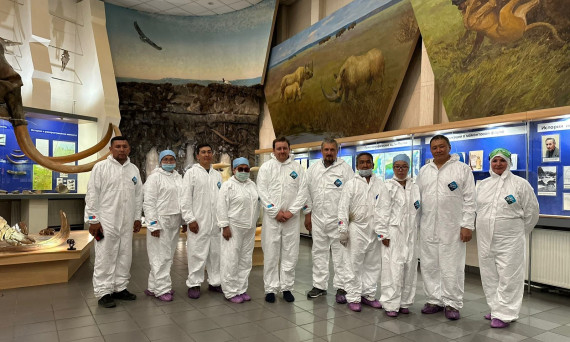Artem Nedoluzhko, Scientific Director of the Laboratory of Paleogenomics of the European University, together with colleagues from the Academy of Sciences of the Republic of Sakha (Yakutia), the North-Eastern Federal University (NEFU) and the Institute of Experimental Medicine, took part in the autopsy of a carcass of a fossil wolf more than 44 thousand years old. This study was carried out at the laboratory of the Mammoth Museum in Yakutsk. The autopsy of the museum specimen will reveal what this ancient predator ate, what bacteria made up its microbiota, and what parasites infected it.
In the course of the work, samples of internal organs and the contents of the gastrointestinal tract were taken to study ancient viruses and microbiota, as well as the diet of the animal. In addition, samples of the ancient predator’s soft tissues were taken to study its genome and compare it with the genomes of its modern relatives. This is the first find, unparalleled in the world, of a fully preserved carcass of an adult predator of such geological age.
In the words of Artem Nedoluzhko:
It is believed that the ancestors of modern humans appeared in Northeast Asia no more than 25,000 to 30,000 years ago, and this date is constantly shifting due to modern methods of natural science. This study could potentially turn out to be a search for DNA molecules of ancient humans in the contents of the gastrointestinal tract of the Pleistocene wolf. It is known that wolves accompanied ancient people, feeding on kitchen waste near Paleolithic sites. In some cases, they may have attacked our ancestors, or eaten their fecal matter. The potential discovery of human DNA in the gastrointestinal tract of a wolf would rewrite the history of human settlement across Eurasia and their expansion into North America.
Note: In 2021, a well-preserved fossil wolf mummy was discovered by local residents at a depth of about 40 meters in the permafrost on the Tirekhtyakh River in the Abyysky district of Yakutia. The find was transferred for scientific research to the Academy of Sciences of the Republic of Sakha (Yakutia).
Photo: Participants at the autopsy of an ancient wolf in the at the laboratory of the Mammoth Museum of the North-Eastern Federal University (NEFU) in Yakutsk
NEFU Press Service
